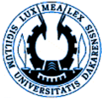Guinea Baboon Research
Baboons (Papio spp.) constitute an important model in the study of primate social evolution as they show considerable variation in many aspects of their social behavior. While most taxa have been well studied, less was known about Guinea baboons (P. papio). Previous observations indicated that they differ from other baboon taxa, for example by exhibiting high rates of male-male affiliation. Comparative analyses of their social and communicative behavior, ecology, and population genetic structure is expected to reveal insights into the selective forces shaping primate social evolution.
Field site

In 2007, we initiated a long term study on wild Guinea baboons. The study community ranges near the field station “Centre de Recherche de Primatology (CRP) Simenti” located in the Niokolo Koba National Park in Senegal. Currently, several subgroups including more than 180 individuals are under study. We also study the local Green monkeys.
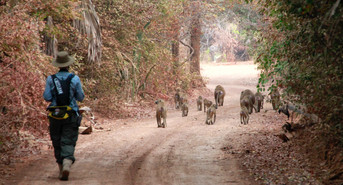
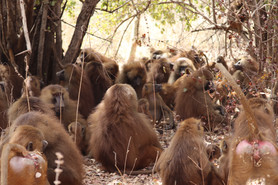
Selected Projects
Male bonds and reproductive success
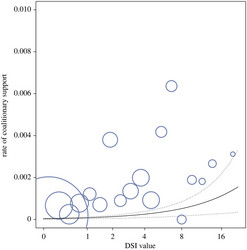
Male–male bonds may confer substantial fitness benefits. The adaptive value of these relationships is often attributed to coalitionary support, which aids in rank ascension and female defence, ultimately resulting in greater reproductive success. We investigated the link between male–male sociality and both coalitionary support and reproductive success in wild Guinea baboons. This species lives in a tolerant multi-level society with reproductive units comprising a male and 1–6 females at the core. Males are philopatric, form differentiated, stable and equitable affiliative relationships (strong bonds) with other males, and lack a clear rank hierarchy. Here, we analysed behavioural and paternity data for 30 males and 50 infants collected over 4 years in the Niokolo-Koba National Park, Senegal. Strongly bonded males supported each other more frequently during conflicts, but strong bonds did not promote reproductive success. Instead, males that spent less time socializing with other males were associated with a higher number of females and sired more offspring. Notably, reproductively active males still maintained bonds with other males, but adjusted their social investment in relation to life-history stage. Long-term data will be needed to test if the adaptive value of male bonding lies in longer male tenure and/or in promoting group cohesion.
Link to Paper
Kin bias and male bonds
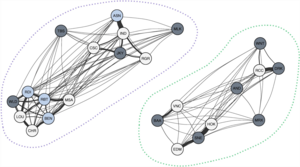
Male-male social relationships in group-living mammals vary from fierce competition to the formation of opportunistic coalitions or the development of long-lasting bonds. We investigated male-male relationships in Guinea baboons (Papio papio), a species characterized by male-male tolerance and affiliation. Guinea baboons live in a multi-level society, with units of one reproductively active “primary” male, 1–6 females, and offspring at the core level. Together with “bachelor” males, several units form a party, and 2–3 parties constitute a gang. We aimed to clarify to which degree male relationship patterns varied with relatedness and pair-bond status, i.e., whether males had primary or bachelor status. Data were collected from 24 males in two parties of Guinea baboons near Simenti in the Niokolo-Koba National Park in Senegal. Males maintained differentiated and equitable affiliative relationships (“strong bonds”) with other males that were stable over a 4-year period, irrespective of their pair-bond status. Remarkably, most bachelor males maintained strong bonds with multiple primary males, indicating that bachelor males play an important role in the cohesion of the parties. A clear male dominance hierarchy could not be established due to the high degree of uncertainty in individual rank scores, yet bachelor males were more likely to be found at the low end of the dominance hierarchy. Average relatedness was significantly higher between strongly bonded males, suggesting that kin biases contribute to the social preferences of males. Long-term data will be needed to test how male bonds affect male tenure and ultimately reproductive success.
Link to Paper
Group coordination
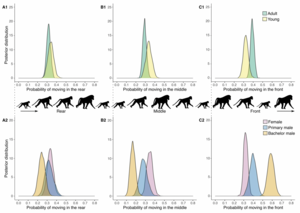
Collective movement of social groups requires coordination between individuals. When cohesion is imperative, consensus must be reached, and specific individuals may exert disproportionate influence during decision-making. Animals living in multi-level societies, however, often split into consistent social subunits during travel, which may impact group coordination processes. We studied collective movement in the socially tolerant multi-level society of Guinea baboons (Papio papio). Using 146 group departures and 100 group progressions from 131 Guinea baboons ranging in Senegal’s Niokolo-Koba National Park, we examined individual success at initiating group departures and position within progressions. Two-thirds of attempted departures were initiated by adult males and one third by adult females. Both sexes were equally successful at initiating departures (> 80% of initiations). During group progressions, bachelor males were predominantly found in front, while reproductively active ‘primary’ males and females were observed with similar frequency across the whole group. The pattern of collective movement in Guinea baboons was more similar to those described for baboons living in uni-level societies than to hamadryas baboons, the only other multi-level baboon species, where males initiate and decide almost all group departures. Social organization alone therefore does not determine which category of individuals influence group coordination.
Link to Paper
Comparative ecology
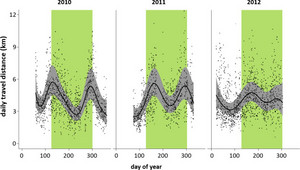
Thorough knowledge of the ecology of a species or population is an essential prerequisite for understanding the impact of ecology on the evolution of their respective social systems. Because of their diversity of social organizations, baboons (Papio spp.) are a useful model for comparative studies. Comparative ecological information was missing for Guinea baboons (Papio papio), however. Here we provide data on the ecology of Guinea baboons in a comparative analysis on two geographical scales. First, we compare climate variables and land cover among areas of occurrence of all six baboon species. Second, we describe home range size, habitat use, ranging behaviour, and diet from a local population of Guinea baboons ranging near the Centre de Recherche de Primatologie (CRP) Simenti in the Niokolo-Koba National Park, Senegal. Home ranges and daily travel distances at Simenti varied seasonally, yet the seasonal patterns in their daily travel distance did not follow a simple dry vs. rainy season pattern. Chemical food composition falls within the range of other baboon species. Compared to other baboon species, areas occupied by Guinea baboons experience the highest variation in precipitation and the highest seasonality in precipitation. Although the Guinea baboons' multi-level social organization is superficially similar to that of hamadryas baboons (P. hamadryas), the ecologies of the two species differ markedly. Most Guinea baboon populations, including the one at Simenti, live in more productive habitats than hamadryas baboons. This difference in the ecology of the two species contradicts a simple evolutionary relation between ecology and social system and suggests that other factors have played an additional role here.
Link to Paper
Methods
- Behavioral observations
- GPS-collars to collect ranging data
- Acoustic recordings
- Playback experiments
- Measurement of steroid hormones
- Kinship analyses
- Investigation of functional polymorphisms
Collaborations
- Direction des Parcs Nationaux, Senegal
- Université Cheikh Anta Diop, Dakar, Senegal
- Endocrinology Laboratory (DPZ)
- Primate Genetics Laboratory (DPZ)

